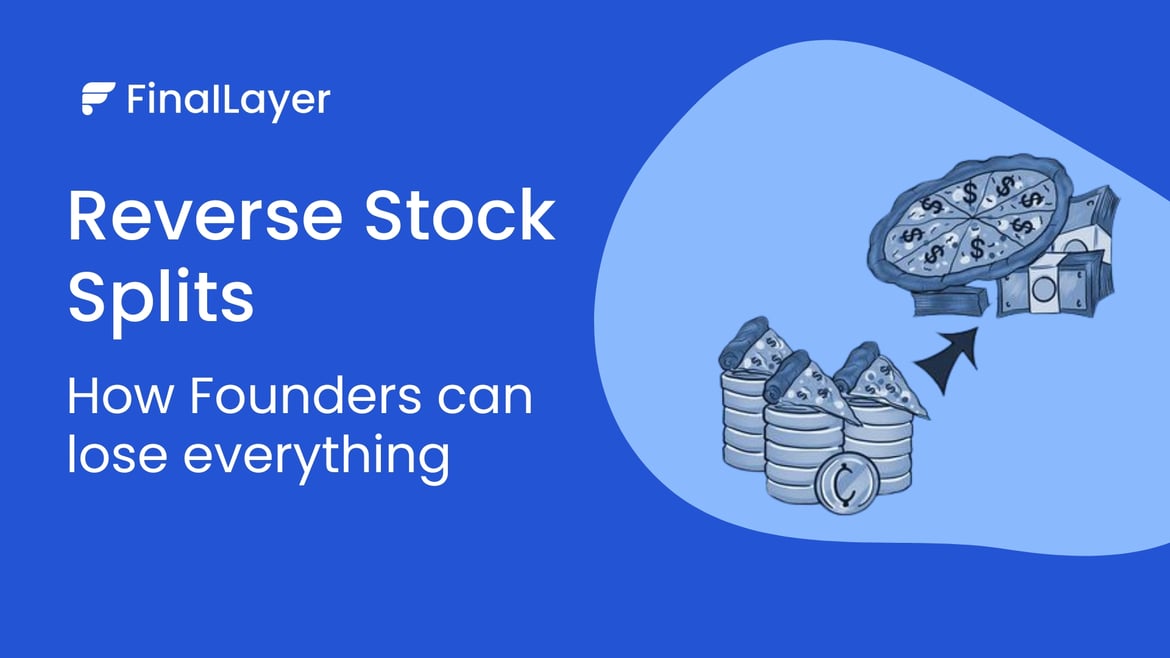Let's talk about reverse stock splits and what those mean for founders and early team members who helped build a company.
Understanding Reverse Stock Splits
Reverse stock splits are often done in order to do some sort of cleanup of the cap table, especially getting rid of people who are long gone from the company and are no longer associated with its services. The mechanics are straightforward: if you have 1,000 shares before a 10-to-1 reverse split, you'll have 100 shares afterward. The share price theoretically increases proportionally, so your total value stays the same in a vacuum.
So when this happens, a certain class of shares, typically the preferred shares, would go through a reverse stock split unless those investors who invested long time ago would come back and participate in the pro rata for the company. This mechanism gives old investors a choice: either invest more money to maintain your stake, or accept dilution through the reverse split.
When and Why Companies Use Reverse Splits
Usually this happens when the company is going through hard times and it's the new money that's going to infuse new life into the company. The reverse split becomes a tool for the board to clean house and make room for new investors who are willing to provide the capital the company needs to survive.
Occasionally, as it happened to us, the reverse stock split may be applied to common shares as well, which means that you're throwing out certain people from the cap table who have provided services before but are no longer providing services. This is where things can become particularly problematic for founders and early employees who helped build the company but are no longer involved.
How Value Actually Gets Redistributed
Now, what a reverse split does is it actually makes everybody's stake worth one tenth of what it was in a 10-to-1 split. Now, if nothing happened after that, you're absolutely correct, then everyone's stake would remain the same proportionally. However, that's not what would happen in practice.
You do the reverse split instead in order to give more shares to those who are actively giving services to the company. So all of those people would now occupy a bigger part of the cap table. The new investors coming in get their shares. The active team members get new option grants. Everyone still involved benefits from the restructuring.
So effectively, those who have left will have their worth decimated to one tenth, and those who remain would be given more options and things like that. This is the mechanism by which departed founders and employees lose their equity stake, even though they contributed years of work to building the company's foundation.
The Mandatory Pro Rata Problem
Now, in a situation like ours where the reverse stock split happened within three months of us leaving after 10 years of service, and especially as it was applied to common stock with a mandatory pro rata, which meant that we needed to pay hundreds of thousands of dollars in order to not be impacted by this reverse stock split, which we couldn't afford.
Think about this dynamic carefully. You've spent a decade building a company, often at below-market or zero salary. You're then replaced or leave the company. Within three months, the company implements a reverse stock split with a mandatory pro rata. To maintain your equity stake, you'd need to invest hundreds of thousands of dollars. If you can't afford it or choose not to invest more, your equity gets decimated to one-tenth its previous value while everyone still at the company gets more shares.
The Ethical vs Legal Question
So in those situations, it is a very gray area. For example, the right thing to do would have been to buy out our stake in the company if they didn't want us on the cap table. Clearly, the management was not interested in spending any money on us. They just wanted to decimate our value.
So it's a tough situation. It does happen more often than people realize. Some people have asked if it is legal to do this. It's very complex as a topic. Every situation is very unique and depends on the specific terms in your stock agreements, the company's bylaws, state law, and the circumstances around the split.
And of course, I can tell you that the ethical thing to do would have been to buy us out. But in terms of what is legal, I think we have a lot of evidence to prove that there's a lot of self-dealing involved in this case. However, that's a complex topic that requires legal expertise, and I'm not an expert on it, so I'm not going to talk much more about that specific aspect.
What Founders Should Know
The key lesson here is that reverse stock splits can be used as a mechanism to remove departed founders from the cap table without paying them fair value for their equity. While the stated purpose is often "cap table cleanup," the practical effect is wealth transfer from those who left to those who remain.
If you're a founder who's considering leaving or being pushed out of your company, understand that a reverse stock split with mandatory pro rata could be coming. If you can't afford to participate in the pro rata, your years of equity accumulation could be reduced to nearly nothing.
The most founder-friendly approach would be for the company or new investors to buy out departed founders at a fair valuation. But when companies are in distress and raising new capital, spending money to buy out former founders is rarely a priority. The reverse split becomes the financially expedient solution for everyone except the departed founders.
Protecting Yourself
While reverse stock splits are a legitimate corporate tool, how they're applied matters enormously. If you're negotiating departure terms from a company you founded or helped build, consider whether protection against punitive reverse stock splits should be part of your separation agreement. This is especially important if the company is struggling and new financing rounds are likely.
Understanding these mechanisms before you're in the situation gives you more leverage to negotiate fair terms. Once the reverse split is announced, your options become much more limited.
At FinalLayer, we're building with the painful lessons from experiences like these. Clean cap tables with aligned incentives aren't just good practice. They're essential to building something sustainable where everyone who contributed meaningfully to the company's success is treated fairly.
If you want to discuss cap table management and founder equity with other founders who've navigated these challenges, join our founder's Slack community where we share experiences and lessons learned from both successes and failures.











